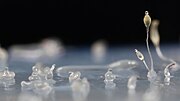 | Amoeba (redirect from Amebas (pseudopodia protists)) David J. Patterson. "Amoebae: Protists Which Move and Feed Using Pseudopodia". Tree of Life web project. Archived from the original on 15 June 2010... 41 KB (3,651 words) - 12:52, 17 April 2024 |
 | Filopodia (redirect from Filose pseudopodia) Filopodia (sg.: filopodium) are slender cytoplasmic projections that extend beyond the leading edge of lamellipodia in migrating cells. Within the lamellipodium... 12 KB (1,172 words) - 14:14, 5 April 2024 |
autotrophic, or heterotrophic organisms. It is characterized by flagella, pseudopodia, or both. It is divided into three subphyla: the Mastigophora, the Sarcodina... 3 KB (221 words) - 18:03, 3 November 2023 |
Melanosome (section Pseudopodia and tanning) can extend its surface lengthwise as temporary projections known as pseudopodia, which carry melanosomes away from the center of the cell, thereby increasing... 11 KB (1,181 words) - 00:47, 27 February 2024 |
 | flattened cells, and Tubulinea, which has predominantly tube-shaped pseudopodia. The group includes eukaryotic cells that, for the most part, have a... 9 KB (1,112 words) - 01:19, 29 April 2024 |
 | a family of Amoebozoa, including naked amoebae that produce multiple pseudopodia of indeterminate length. These are roughly cylindrical with granular... 2 KB (154 words) - 21:18, 8 November 2023 |
 | of the cell involving the formation of pseudopodia ("false-feet") and posterior uropods. One or more pseudopodia may be produced at a time depending on... 17 KB (2,106 words) - 10:47, 24 July 2023 |
 | Aquatic locomotion (section Pseudopodia) Aquatic locomotion or swimming is biologically propelled motion through a liquid medium. The simplest propulsive systems are composed of cilia and flagella... 49 KB (6,577 words) - 04:20, 1 April 2024 |
several delicately thin and stiff pseudopodia extend, each one bearing a small number of granules. Their pseudopodia remain adhered to the substrate, as... 2 KB (182 words) - 22:45, 16 April 2024 |
 | at some point during their life cycle. Amoeboflagellates present both pseudopodia and at least one flagellum, often simultaneously. The amoeboflagellate... 5 KB (1,202 words) - 17:15, 9 February 2024 |
 | in having granuloreticulose pseudopodia; that is, their pseudopodia appear granular under the microscope; these pseudopodia are often elongate and may... 86 KB (8,432 words) - 19:55, 7 April 2024 |
 | often provided by cilia or flagella or may proceed via the advance of pseudopodia, food may be gathered by phagocytosis, energy needs may be supplied by... 80 KB (8,860 words) - 14:31, 11 April 2024 |
 | described Image Amoebozoa Amorphous animals Amoebozoans Presence of pseudopodia for amoeboid movement, tubular cristae. approx. 2,400 Apicomplexa Apical... 60 KB (4,134 words) - 04:08, 25 March 2024 |
 | Acrasids, which have sluglike amoebae. In locomotion, the amoebae's pseudopodia are eruptive, meaning that hemispherical bulges appear at the front.... 54 KB (5,526 words) - 01:34, 20 April 2024 |
 | form platelet ribbons into blood vessels. The ribbons are formed via pseudopodia and they are able to continuously emit platelets into circulation. In... 16 KB (1,787 words) - 17:27, 22 February 2024 |
 | shape. Members of the group do not produce tubular or subcylindrical pseudopodia, like amoebae of the class Tubulinea. When a discosean is in motion,... 8 KB (714 words) - 04:56, 25 October 2022 |
filamentous pseudopodia, extrusomes close to the substrate, and two short inactive flagella that measure 4–6 μm. The arrangement of their pseudopodia are reminiscent... 3 KB (339 words) - 19:43, 12 April 2024 |
Actinophryida, an order of heliozoa, amoebae with stiff specialized pseudopodia called axopodia. Cavalier-Smith, Thomas; Scoble, Josephine Margaret (2013)... 2 KB (130 words) - 01:54, 4 October 2023 |








